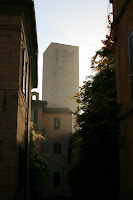 With mid-terms coming to an end, (HOORAY!) and spring break fast approaching (HIP-HIP HOORAY!) we know that many of you Umbra students will leave your text books behind for the week and head out of Italy on an adventure across Europe.
With mid-terms coming to an end, (HOORAY!) and spring break fast approaching (HIP-HIP HOORAY!) we know that many of you Umbra students will leave your text books behind for the week and head out of Italy on an adventure across Europe.
As you’ve probably already had the opportunity to experience this semester, Italy’s central European location makes jetting off to popular destinations like Paris and Prague pretty easy. From Perugia, you’ll take a two-hour bus or train ride to Rome where you’ll hop on a low-cost airline which will take you to your chosen destination.
Depending on where you’re going, you’ll probably experience even more means of transportation once you arrive. If you’re going to Paris, you’ll hop on the metro. If you’re in London, you’ll “mind the gap” and get on the tube. If you’re going to be in Amsterdam, you’ll see that bicycles are a popular choice for getting around. And if you go to Greece or Croatia, you’ve probably got a few ferries to catch.
Wherever this break may take you, from Croatia or the Canary Islands, happy trails and safe travel to you!




 Umbra students are constantly on the move. Visiting cities and sites all over Italy and adventuring through Europe as well. With Spring Break just around the corner, students have already began to get their feet wet by traveling to some popular destinations. Below is an excerpt from Umbra students Erin Costello and Chris Smith about their time spent in London:
Umbra students are constantly on the move. Visiting cities and sites all over Italy and adventuring through Europe as well. With Spring Break just around the corner, students have already began to get their feet wet by traveling to some popular destinations. Below is an excerpt from Umbra students Erin Costello and Chris Smith about their time spent in London: If you have at all thought about going to London, we highly recommend it.
If you have at all thought about going to London, we highly recommend it.

 graduating college.
graduating college. a Francesca (Duke of Urbino portrait). As stated in Turpin’s statement: “My paintings incorporate Renaissance themes and imagery, but superimpose not what was culturally acceptable in Renaissance times, but rather what we today as a culture publicly accept through our images of violence, sex, and drugs seen in our mass media. By exploring this dichotomy of Renaissance and modern popular culture, I hope the viewers can decide for themselves the trouble that might be associated with this type of blind societal acceptance of popular culture which has become so commonplace that we forget what implications it might have.”
a Francesca (Duke of Urbino portrait). As stated in Turpin’s statement: “My paintings incorporate Renaissance themes and imagery, but superimpose not what was culturally acceptable in Renaissance times, but rather what we today as a culture publicly accept through our images of violence, sex, and drugs seen in our mass media. By exploring this dichotomy of Renaissance and modern popular culture, I hope the viewers can decide for themselves the trouble that might be associated with this type of blind societal acceptance of popular culture which has become so commonplace that we forget what implications it might have.” sister city of Seattle, Washington. This video traces the history of Perugia back to the Etruscans, while also exploring issues of modernization in the city. Spend 26 minutes with host Mike James to learn more about the city, people, art, music, food, and shopping which provide the “human side of life” in Perugia.
sister city of Seattle, Washington. This video traces the history of Perugia back to the Etruscans, while also exploring issues of modernization in the city. Spend 26 minutes with host Mike James to learn more about the city, people, art, music, food, and shopping which provide the “human side of life” in Perugia. 
